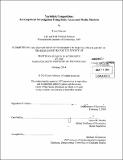Yardstick Competition : an empirical investigation using state taxes and media markets
Author(s)
Johnson, Lynn Christine, 1976-
DownloadFull printable version (1.732Mb)
Other Contributors
Massachusetts Institute of Technology. Department of Economics.
Advisor
James M. Poterba.
Terms of use
Metadata
Show full item recordAbstract
I investigate whether voters judge the performance of their governor on taxes by comparing him to governors from neighboring states. If voters do make these comparisons, it creates "yardstick competition," where governors are competing with each other as they set taxes. Previous research has shown that governors are punished at the ballot box for raising taxes. However, Besley and Case (AER 1995) find that if governors in neighboring states have also raised taxes the voters are more forgiving. Besley and Case speculate that voters know what is happening in other states through the media. My hypothesis is that if yardstick competition exists, then voters exposed to television from a neighboring state should be influenced by tax changes in that state. For example, there are some counties in eastern Arkansas where voters are watching Tennessee television stations and some in southern Arkansas where they are watching Louisiana television stations. By comparing the voting patterns in these counties in the Arkansas gubernatorial election, I can see if there is any influence coming from the taxes set by the neighboring state. I control for the typical partisan leanings of the county as measured by presidential and senatorial votes in nearby years. Therefore I incorporate county voting data for every election from 1960 to 2000, and I use tax data from the NBER TAXSIM program and other sources. I find only very limited evidence in support of yardstick competition. Specifically, voters seem to make yardstick comparisons for the personal income tax when both governors are Democrats. This may be consistent with a theory where voters can only judge whether a tax increase was warranted when they are comparing governors from the same party, and it supports a growing literature in political science suggesting that voters have different expectations of the two parties on fiscal issues.
Description
Thesis: S.M., Massachusetts Institute of Technology, Department of Economics, 2014. Cataloged from PDF version of thesis. Includes bibliographical references (pages 21-22).
Date issued
2014Department
Massachusetts Institute of Technology. Department of EconomicsPublisher
Massachusetts Institute of Technology
Keywords
Economics.